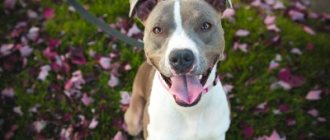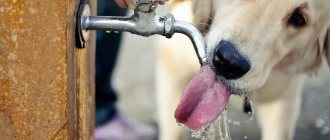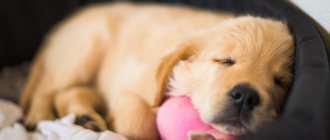- Dogs
Every responsible owner should know why a pet doesn't drink enough, why a dog drinks a lot of water, and what kind of water will be beneficial. Water is the most important element in the body of mammals. Even bones need fluid, not to mention blood and lymph. Insufficient fluid intake or drinking poor-quality water can provoke a variety of diseases and will bring you closer to old age. How much and what kind of water should you give your dog, and when is it time to sound the alarm?
How much should a dog drink?
To determine whether a dog drinks enough water per day, you need to multiply 20 and 70 mg by its weight. So, a dog weighing 20 kilograms per day should drink from 400 to 1400 milliliters of liquid . This difference depends on various factors:
- air temperature and humidity
- physical activity of the animal
- his individual characteristics
If a dog eats ready-made canned food or natural food: liquid porridge, kefir, broth, then it will need less pure water. And in winter, such a dog can not drink water at all and feel great. When feeding dry food, the dog must drink.
Does a dog need water in winter?
In winter, a pet that lives outside must have water. In cold weather, the animal also cannot live without liquid. Therefore, a person must ensure that the dog’s water bowl is replaced at least three times as the water freezes in the cold. Don't think that snow can replace a four-legged drink.
Water intake in winter for dogs
Why doesn't the dog drink water?
If a dog drinks little water, this fact is not necessarily associated with health problems. It is possible that the animal is getting enough moisture from its food, especially if it is natural feeding or feeding wet commercial food. Wet food contains about 70-80% moisture. By the way, when switching a pet from dry food to natural feeding, they consume less water.
- Older dogs drink less, their appetite may decrease, and at the same time the feeling of thirst decreases. Older animals forget to quench their thirst or cannot find a bowl of water due to cognitive impairment (memory impairment), or the water is too far away and the animal does not want to put in much effort to get there.
- Poor health, accompanied by a number of signs, may indicate a disease. In the presence of injury, digestive upset, toothache, poisoning, pancreatitis, a foreign body entering the gastrointestinal tract, as well as being in a stressful, depressive state, dogs do not drink water or drink very little. If your pet's refusal to drink water is not related to health problems, then you should pay attention to the quality of the water.
- The drinking water in the bowl should be fresh and cool and should be changed at least 2 times a day. The dog may not like the taste and smell of water, which can be transmitted from a plastic bowl. It is better to use small ceramic bowls so that the water does not stagnate and remains cool. When changing water, the bowl should be washed and thoroughly rinsed off detergents, if used.
- Perhaps the dog does not drink water because it is warm or very cold, or has an unpleasant taste due to the content of harmful metals, chlorine, and salts in the case of tap water. It is better to filter it or buy bottled. If the steps taken do not help and the dog does not drink water, then you should think about purchasing a drinking fountain. It has been noticed that pets are more willing to drink water from a drinking fountain than from a regular bowl, because the liquid in the fountain is constantly circulating, cooled and cleaned.
Additional sources of moisture can be fruits and vegetables, which are beneficial for animals. Vegetables and fruits should be given raw. You can force a dog to drink water by improving its taste - adding berries or pieces of fruit to the water that the pet loves, but are harmless to its body . To cool the water, you can add ice cubes to it. Another way to get your dog to drink water is to place a bowl of water near the dog's sleeping area or in areas that the dog visits most often. You can give your pet a treat or otherwise praise him every time he drinks water.
About water quality
In early childhood, each of us was taught to drink boiled water, why? Because the water in the tap is “dirty”. Many people have probably wondered why clean and even sometimes tasty water is called bad. Growing up, many began to drink water from the tap... and nothing bad happened. So why do parents “instinctively” boil water for their children? Where did this “tradition” come from?
In fact, there is no mystery in boiling water. An adult knows that his mother, grandmother, and great-grandmother boiled water and repeats this ritual because “it’s necessary.”
In fact, the procedure of boiling water allows you to completely clean it of helminth eggs and partially of:
- Salt.
- Alkalis.
- Chlorine.
- Hydrogen sulfide.
The key word here is partial, because depending on the region, the condition of reservoirs and treatment plants, water may contain pesticides, heavy metals, nitrates and many other unpleasant components. Unfortunately, most people (if we are not talking about developed countries) have industrial water flowing from their taps that is unsuitable for drinking and cooking.
There are many opinions about the dangers and benefits of tap water. Some people fanatically call bottled water dead, others do not risk cooking with tap water because it leaves behind scale. We will not participate in this dispute; we will only talk about the facts that we know.
Manufacturers of bottled water do not hide the composition of their product, but there are some nuances. You don’t go to a sedum plant before buying water, you don’t check whether everything is as the manufacturer claims, and you don’t submit the water for laboratory analysis. You trust your sense of taste, at best, check whether scale remains after using purchased water . If there is no plaque or scale, the water is automatically recognized as purified. In most cases, this method is quite reliable and there is a reason for this.
Purified water producers do not extract their product from wells. The raw material is tap water, which is passed through several filters and then, at the request of the manufacturer, ionized, mineralized or enriched in another way. Only mineral water is extracted from wells.
Most people make guesses about the composition of tap water, but few people get around to checking their intuition, that is, having the water analyzed. Fortunately, there are methods to keep running water safe, including:
- Use water filters.
- Install a permanent filtration system (reverse osmosis).
- Boil water, which will eliminate most of the harmful substances.
The next question is what kind of water can you give your dog and is it tap water? General recommendations are as follows: if the tap water in your city is not of disgusting quality, it can be given to your dog. How you assess the condition of the water is a personal matter. As a last resort, you can use water for your pet. It is interesting that these recommendations contradict the instructions of modern experts, who advise giving pets only purified water (through a filter or purchased). Who is right?
Note! There are often recommendations that water for dogs needs to be settled.
The instructions are as follows: take water into an open container, let it stand in a dark place for at least a day (during this time the residual chlorine will disappear), carefully pour 2/3 of the water (top layers) into a clean container, pour out the rest of the water (there is sediment in it). It is important to carry out the procedure carefully so that the settled solids do not mix with the upper layers of water.
Everyone is partially right. A dog should not be given only purified water (this means from birth and throughout its life), since sooner or later it will be tempted to drink water from a puddle or someone else's bowl. If the animal's intestinal microflora is not ready for bacterial invasion, the dog will be poisoned. You should not give only tap water, especially if you are caring for an old dog or a pet with a predisposition to pathologies of the genitourinary system. In this case, maintaining health and reducing the burden on the body is a more important factor.
So, the conclusion is the following - it is important to find a middle ground and not go to extremes . It is equally important to monitor the dog’s health and the amount of water it consumes. It is advisable to focus on your pet’s preferences, that is, give him the water that he drinks better.
Natural increase in thirst in dogs
As in any living organism, changes may occur in your pet, leading to high fluid consumption. In such a situation, the animal begins to consume more fluid than indicated by the norm. This behavior may have a connection with pathological conditions of the body, when the disease is accompanied by increased thirst, but one should not immediately exclude causes of natural origin that are in no way related to disease.
Increased thirst may occur for the following reasons:
- during pregnancy;
- increased activity of the pet;
- in the warm season during the heat;
- if the dog stays in a room with high temperature and dry air for a long time;
- consumption of a number of foods that have a diuretic effect (rice, apples, pumpkin, carrots, herbs, cucumbers, etc.);
- if the food contains a lot of salt;
- if the diet includes little protein foods.
The group of natural causes also includes taking certain medications:
- drugs with a pronounced diuretic (diuretic) effect;
- corticosteroids;
- injection of Xylazine hydrochloride, which has a sedative, analgesic, anesthetic effect, and is also a muscle relaxant. The drug is used to immobilize the animal.
In addition, the dog's thirst may increase due to a stressful situation when the pet is experiencing strong excitement. In this case, polydipsia is psychological in nature.
Treatment
You should be careful here, since at home it is difficult to understand what exactly is happening to the animal.
When dehydration occurs, it is important to find out and eliminate the cause. All you can do is not restrict the animal from water and show it to the veterinarian.
In case of poisoning, it is very important to act quickly. The most effective treatment is in the first 12 hours. The first thing to do is to cleanse the stomach (induce vomiting) using specialized emetics, or you can use regular hydrogen peroxide.
Be sure to dilute it with water so as not to cause a burn to the mucous membranes! Inject directly into the throat.
You can also use Vaseline oil. After washing the stomach, we give sorbents to remove toxins from the body. This can be Enterosgel or Polysorb. Further actions and choice of drugs depend on the substance that caused the poisoning.
Treatment of endocrine disorders consists of hormone therapy under the strict supervision of a veterinarian.
Problems of the genitourinary system should be treated as prescribed by a veterinarian in each individual case. The main thing is not to limit your dog’s drinking. Special diets of food from the “Urinari” line are also prescribed.
If you are dealing with liver disease , the challenge is to find and prevent the cause. And the liver itself will recover perfectly as soon as the pathological factor is eliminated.
Do not self-medicate; be sure to show the animal to a specialist.
Thirst of pathological origin
But everything is not always so harmless; often the dog begins to drink a lot due to the fact that a disease develops in his body. And drinking plenty of food in this case is a protective reaction of the body, protecting it from possible dehydration.
The list of diseases of which polydipsia is a symptom includes the following ailments:
- hypercalcemia (increased calcium levels in the plasma part of the blood);
- hypocalcemia (pathological decrease in calcium levels);
- diseases associated with hormonal levels (diabetes mellitus and insipidus, thyrotoxicosis, acromegaly);
- tumor formations in liver tissue, as well as other oncological diseases;
- inflammatory processes in the liver (hepatitis);
- accumulation of purulent-inflammatory fluid in the uterine cavity;
- hypothalamic diseases;
- manifestation of pericardial effusion;
- increase in red blood cells in the bloodstream;
- renal failure in acute or chronic form;
- inflammation of the kidneys (pyelonephritis);
- glomerular nephritis;
- urethral obstruction.
Since there are many diseases that cause polydipsia, owners should not try to diagnose the disease on their own. It would be better to seek advice from a specialist.
- Dog breeds
- Urban dog breeds
- Origin of the cat
- Hypoallergenic dogs
- Fighting dog breeds
- The rarest cat breeds
What types of water are strictly prohibited?
What really should not be allowed is quenching thirst in stagnant bodies of water (due to the critically high probability of containing parasite larvae and pathogenic bacteria in them), and drinking so-called technical water (which is not originally intended for drinking and cooking due to its content in no solid particles).
While on the road, it can be quite difficult to provide water for your pet. For such cases, it is worth buying a travel drinking bowl, which is also a convenient source of quenching thirst for dogs. This is a bottle with a bowl lid designed for drinking. Buying a travel water bottle will make your life much easier when traveling, and you can purchase it at any pet store. Due to the fact that these products are made from different materials, and they have a simpler or more complex configuration, prices for drinking bowls vary from an affordable couple of hundred to more expensive ones, over a thousand rubles.
What should you not give your dog?
You should not give your dog industrial water with a high content of solid particles. The permissible degree of mineralization of water for dogs is 5 thousand solid particles per 1 million particles of water. It is strictly not recommended to allow your dog to drink water from stagnant bodies of water. Such water may contain pathogenic bacteria, parasite larvae, and leptospirosis pathogens.
Should you boil water for your dog or not?
If your tap water is of tolerable quality, you don't need to boil it. But if it is completely unsuitable for consumption (you do not use it for cooking), it is better to boil the water.
The dog drinks water greedily and immediately burps: the reason
If a dog greedily drinks water after eating and then burps, then in most cases there is nothing wrong with it. Perhaps the animal simply does not control its “appetite”. Or this happens due to overexcitation, stress, or active games.
Thirst in dogs
IMPORTANT : If vomiting occurs regularly after drinking in adult dogs, then it may have problems with the digestive tract, blockage or defect of the esophagus from birth. You cannot do without the help of a specialist doctor.
Which water bowl is best?
The most important thing in a dog's water bowl is that it contains clean, fresh water. Buy a water bowl based on the size of your pet - make it larger rather than smaller. There is no particular difference in the material from which the water bowl is made. Avoid cheap plastic - it can leach substances into the water that are harmful to your dog. It is better if it is a special bowl made of food-grade plastic or stainless steel. Pet stores sell special bowls for dogs on a rubber stand; they are convenient because they are very stable and do not slip on the floor surface.
How often should you wash the water bowl?
Water and food bowls should be washed with soap and water daily. Because these bowls come into contact with your pet's food and saliva, they tend to be good places for bacteria to grow.
Bowls should be smooth and easy to clean, with no nooks and crannies or even scratches where bacteria can hide and survive.
If you are concerned that your dog is not getting enough water to stay healthy or is drinking too much water, consult your veterinarian.
Maintaining proper hydration is too important to your dog's health to be ignored.
How to water a dog on the road?
If you are traveling by car with your dog, you may want to bring a homemade bowl for your dog and a bottle of clean water. If you have to walk and don’t really want to carry extra weight with you, pay attention to special travel water bowls for dogs. You can buy them at any pet supply store. They are inexpensive, but your trip will be comfortable for both you and your dog. A travel water bottle for dogs, or as it is also called, is an ordinary bottle with a lid that also serves as a bowl.
Raw water
Clean, cool water is what you need to cope with thirst. Ordinary tap water will do if you are confident in its quality. If it contains excess chlorine, it must be allowed to settle. When you pour water from the vessel in which it has settled, be careful: what has settled must be left at the bottom; the water from the upper layer must get into the dog bowl. Try to avoid mixing.
If the water is too hard and contains iron and solid particles, use a filter to clean it.
How long can a dog live without water?
It is known that a dog can survive without water for 2-3 days . Environmental factors largely influence, in particular air temperature and humidity, the level of activity of the animal itself and the type of food consumed. Naturally, a dog that is without water, but feeds on the flesh of animals, will live longer than an animal that does not have the opportunity to eat. Lack or absence of water leads to dehydration. With a lack of moisture, the functionality of internal organs, in particular the liver and kidneys, is impaired. As a result, dehydration leads to the death of the animal. Dehydration can be determined by several signs. To do this, you need to pull up the folds of skin above the upper part of the shoulder blade and lower it; if there is no lack of moisture, then the skin will quickly return to its original position , otherwise the skin slowly returns to its place and even remains elongated for some time. You need to check your gums; smooth and moist gums indicate a normal level of moisture, while dry, sticky and pale gums indicate a lack of moisture in the body . When dehydrated, animals have dry and sunken eyes, a dry nose and tongue, and thick saliva.
If your dog drinks a lot of water
Excessive thirst may have explainable reasons, which we discussed above. If your dog has a calm lifestyle, there is no special stress, the house is not hot and the air is sufficiently humidified, the pet does not eat dry food, he does not take medications that could cause thirst, and if you do not have a pregnant or lactating female, but The dog began to drink a lot of water, you should be wary.
There are a number of diseases that cause dehydration and polydipsia (increased thirst). Among them:
- imbalance of calcium in the blood;
- diabetes mellitus and other hormonal diseases;
- tumor formations;
- inflammatory processes in internal organs;
- pathologies of the hypothalamus;
- urethral obstruction and others.
These diseases cannot be diagnosed independently; a serious examination is required, which begins with a blood test of the animal. Do not hesitate to contact a veterinary clinic.
Why do dogs drink toilet water even if their bowl is full of water?
Dogs are scavengers by nature. It really is in their genes and has been going on for thousands of years. Some of us like to think of them as hunters and survivalists, but in reality this is far from the case.
Finding food in trash cans is a favorite activity of dogs, and every owner of this pet knows this. Do you notice your dog rummaging through the trash, sniffing out kitchen scraps, not moving from the grill grate, and eating any scraps that fall on the floor? Yes, dogs just love leftovers. And yes, it is quite natural that they quench their thirst from a source other than a bowl of water.
First , understand that a dog sees the world differently than a human. A dog’s value system and its understanding of good and bad are radically different from human principles. And even if dogs somehow realized what the toilet is for, it would not affect their worldview in any way. For them, drinking from the toilet is not at all disgusting, but rather natural.
Secondly , the water in the toilet is always cool and clean, unless, of course, the toilet itself is dirty. Cold, fresh water is preferable to water at room temperature. In addition, the water we pour for our pets can sit in the bowl for several hours, and pieces of food can also accumulate there. Add to this the fact that water in a metal or plastic bowl can taste like the material it's made from, and you can see why your dog has a particular affinity for toilet water.
Danger of water from puddles and ponds
Lake and river water does not pose a serious danger, but stagnant reservoirs and puddles may contain protozoan organisms that cause health problems, in particular diarrhea and more serious disorders of the gastrointestinal tract. Such organisms include Giardia and Cryptosporidium. Therefore, you should not allow your dog to drink from puddles, lakes, or rivers.
Similar articles:
- How not to feed a dog
- Feeding dogs in hot weather
- Is it possible to give eggs to dogs?
- Is it possible to give dogs onions?
- Feeding a pregnant and lactating dog
- Dairy products for dogs
What do the owners think?
masya.vasya2016
You can calculate the daily water intake for a dog using the formula: multiply 20 and 70 mg by the pet’s weight. For example: a dog weighs 10 kilograms, the required amount of water per day is from 0.2 to 0.7 liters.
valeriy146
If your dog refuses to drink, then you should seriously think about its health and consult a veterinarian. Especially if your pet leads an active lifestyle, but at the same time forgets about water.
rozared2014
Each dog has its own water consumption standards. Pregnant and lactating bitches will drink more, in hot weather - all dogs drink a lot, after a walk they are generally ready to drink a bucket, so there is no common denominator. As for refusing water, there is only one piece of advice: show the dog to a veterinarian.
ivan.woloshin
The age, breed, weight of the dog, and its physical activity affect the amount of water it drinks, so it is impossible to say unambiguously how much it should drink.
many.kolobkowa20
There should be plenty of water, but how much the dog drinks is up to him. I don't think there are any rules about this. The only thing is that the amount of water you drink must be controlled during illness (diarrhea, fever), when there is a very high probability of dehydration.
huprin
If we talk about norms, then for dogs it is 50-70 ml per 1 kg of body weight. I think it won’t be difficult to calculate how much water in liters your dog needs. Just don’t forget about individual characteristics. The amount of water also depends on physical activity, ambient temperature and many other factors.
lila
Usually the dog itself feels how much water it needs, it all depends on the type of food, the amount of food eaten, the temperature in the room... In hot weather, the dog needs more water. The main thing is that the animal always has clean water. The only thing I noticed is that when I pour water from under the filter, mine doesn’t drink it as much as from the tap. I don’t know what the secret is.
Anela
The dog itself feels how much water it needs if water has always been freely available to it since childhood. If water was limited or someone forgot to pour it into a bowl, then the feeling of thirst may gradually be lost. But this does not mean that the dog does not need water... It just doesn’t feel it so keenly anymore.
Water consumption rate
How can you tell if your dog drinks enough water per day? To do this, you need to calculate the rate, and this is done in several ways. Each calculation method cannot be considered true, since there are many factors that influence the amount of water consumed. By calculating the norm, you get an approximate indicator that you need to focus on, but do not strive to strictly adhere to it.
The generally accepted norm is:
- For a puppy, 100 ml of water per 1 kg of weight.
- For an adult dog, 50 ml of water per 1 kg of weight.
An alternative calculation method is also based on weight. Here it is not a clear norm that is calculated, but a range:
- Minimum = dog's weight multiplied by 20.
- Maximum = dog's weight multiplied by 70.
Example: a dog weighs 20 kg. We consider the minimum of 20 multiplied by 20 to be equal to 400. We consider the maximum of 20 multiplied by 70 to be equal to 1400. That is, our dog weighing 20 kg should drink from 400 to 1400 ml of water per day, and on average 400 plus 1400 and divided by 2, we get 900 ml per day. This calculation is more fair, since it takes into account that the dog drinks more in hot weather or after exercise, and less when at rest.
For animals kept on dry food, the calculation is slightly different . The norm is tied to the amount of food the dog consumes per day. You should drink 2 times more water than you eat food. That is, if your pet consumes 400 gr. granules per day, he should drink at least 800 ml of water. When feeding natural food, when calculating using this method, the ratio of the volume (not weight) of water and food should be the same. That is, if a dog eats a liter bowl of porridge per day, then it should drink at least 1 liter of water.
Important! All that has significant energy value is food. Liquid food (soups, cereals and canned food with gravy), milk, fermented baked milk, yogurt and other dairy products, meat and vegetable broths - this is food!
Only unprocessed vegetable juices can be considered water; some dogs drink them with pleasure. Also water can include decoctions (not infusions) of herbs such as chamomile, fennel, dill, but a decoction of flax seeds is already food.
Factors influencing water consumption
It was said above that there are a number of factors that greatly influence the amount of water consumed. We are talking about reasons that are not related to the absorption of water in the body or diseases in which a dog may refuse to take fluids.
An absolutely healthy, pregnant dog will drink more, since its body is constantly producing additional blood and amniotic fluid. After giving birth, a new mother will most likely experience dehydration, so the owner needs to strictly ensure that the pet drinks enough. In the postpartum period, until the dog returns to normal (2-3 days), it is advisable to give it more liquid food (broths, soups), dairy products (if lactose is digestible) and sweet tea.
In hot weather, water consumption increases greatly, which can be considered normal. A dog may drink more if the air temperature is not very high, but is lower. In dry air, a dog's mucous membrane lubrication quickly evaporates. In winter, heating radiators operate in the home, which greatly dries out the air.
A pet may refuse water after sterilization (anesthesia). In this case, you should not forcefully drink water, but if the dog’s mouth is too dry, it needs to be moistened. After operations lasting more than an hour, you need to constantly check the condition of the mucous membranes of the eyes, nose and mouth. If necessary, the eyes and nose are instilled with saline solution, the mouth is moistened with clean water.
How to water a dog on the road?
We need to dwell on this issue in more detail, since not all owners take into account the nuances. If you are going on a trip or a long walk, you need to take water and a bowl for your dog! An alternative option is portable drinking bowls, of which there are about a dozen models. By the way, using a portable drinking bowl can eliminate difficulties if you are afraid to drink water from a bowl. This fear is usually related to the fact that the dog has ever drowned or inhaled water through his nose. A portable water bottle is small and unusual in appearance (compared to a bowl), so your dog will drink from it without worry.
Note! If you don't have a bowl, but have clean water, you can water your dog from the palm of your hand. Some four-legged animals quickly understand that water can be drunk from a bottle and are happy to catch a thin stream of water.
What you should not do is give your dog mineral water. If the situation is critical and there is no store nearby to buy regular bottled water, we do the following. We twist the bottle and shake it as hard as possible. You will feel how the walls of the bottle become harder - this is carbon dioxide. We open the plug, wait until all the gas comes out, close the plug and repeat the procedure. Release the gas from the bottle until the sides remain soft when shaken.
conclusions
The importance of water for the proper functioning of the dog’s body and their condition lies in the fact that water dissolves and transports nutrients in the body. In addition, water plays an important role in helping dogs adjust to ambient temperatures and maintain optimal body temperature to avoid overheating. Therefore, the presence of a certain amount of water in a dog’s body is one of the main conditions for its normal life.
It should also be borne in mind that dogs endure a lack of water much more severely than a lack of all nutrients combined. If, depending on its fatness, a dog can live for several weeks without food, then without water it can die within a few days. And if, during forced starvation, a dog is able to tolerate a loss of 40% of body weight, then if it is deprived of water, it dies with a loss of 22% of body weight.
The water requirement of adult dogs under normal conditions is about 40 ml per 1 kg of body weight per day . In puppies this figure is 2–3 times higher. Also, dogs' need for water depends on their size - the smaller their body weight, the higher the need.
On average, an adult service dog's water requirement is about 2.5 liters per day. 40% of this amount comes from drinking water, 45% is found in soups and feed. The remaining 15% is water, which is formed in the dog’s body as a result of digestive processes.
Dogs need to be given clean, odorless water. It should not be too cold and not too hard. If you give your dog tap water, it is better not to boil it, since boiled water often negatively affects the condition of dogs' tooth enamel. The dog needs to be provided with free access to water, which should be in its usual place.
Video
And which one is prohibited
- First of all, you should not let your dog drink contaminated water from technical fluids - this can be fatal for him. Process water, even well purified, is also harmful.
- Stop your pet from trying to “feast” on water from a puddle or standing pond - this is a real breeding ground for bacteria and other microorganisms that can cause serious illnesses.
- “Tasty” toilet water, so beloved by many dogs, should not be allowed for consumption. The reasons are clear.
- Highly mineralized water is contraindicated for dogs. The maximum permissible level is 0.5%, so it is not recommended to give her this kind of water. If there is no other way out, shake the bottle properly and leave it open for half an hour to an hour, and only then give your pet food.
- Also, under no circumstances should you give her soda, especially sweet soda, even if she is thirsty. The same goes for tea and coffee.
- Over-salted water is prohibited.
- Alcohol is deadly!
Where does the liquid come from and where does it go?
Life-giving moisture enters the body not only from a filled bowl. The dog can receive water from food - natural or wet food. The latter contains 70-80 percent liquid.
It is lost during rapid breathing, sweating through the pads of the paws, and when dealing with natural needs. Painful conditions that cause vomiting and diarrhea lead to severe loss of fluid.
Drinking in unspecified places
Some dogs love to drink from the toilet. This is not the safest way to quench your thirst, so keep the toilet door securely locked. Don't rely solely on the toilet lid being closed. Pets easily open it and get to what they want.
Animals also tend to drink from open city water bodies: rivers and lakes. Most veterinarians do not consider this to be dangerous. Experts do not recommend drinking exclusively from bodies of water with stagnant water: ponds, puddles. However, the best option for caring owners is to keep the dog away from all possible sources of pathogenic bacteria, viruses, and substances harmful to health.











